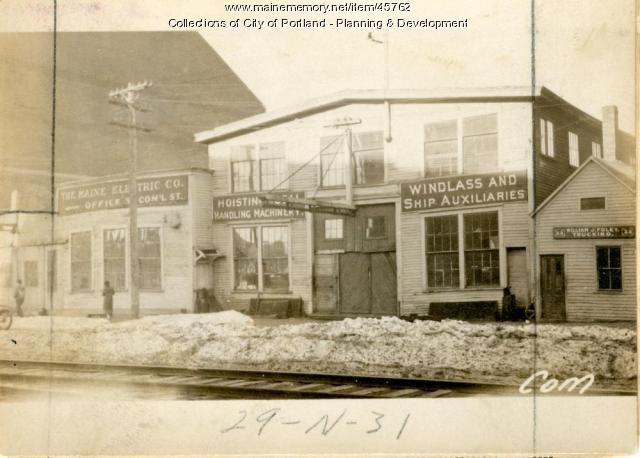Keywords: The Maine Electric Co.
Item 74518
General Electric Type I electric meter, 1913
Contributed by: Maine Historical Society Date: circa 1913 Media: Metal, glass
Item 74517
Westinghouse Round-type electric meter, 1904
Contributed by: Maine Historical Society Date: circa 1904 Media: Metal, glass
Item 37245
37-41 Commercial Street, Portland, 1924
Owner in 1924: S.W. Thaxter & Co. Use: Office & Storage
Item 37239
33-35 Commercial Street, Portland, 1924
Owner in 1924: Galt Block Warehouse Co. Use: Warehouse
Item 109425
Storehouse for Androscoggin Electric Co., Lewiston, 1916-1919
Contributed by: Maine Historical Society Date: 1916–1919 Location: Lewiston Client: Androscoggin Electric Co. Architect: Harry S. Coombs
Item 111980
Steep Falls Library, Standish, 1924
Contributed by: Maine Historical Society Date: 1924 Location: Standish Client: unknown Architect: John Calvin Stevens and John Howard Stevens Architects
Exhibit
Wired! How Electricity Came to Maine
As early as 1633, entrepreneurs along the Piscataqua River in southern Maine utilized the force of the river to power a sawmill, recognizing the potential of the area's natural power sources, but it was not until the 1890s that technology made widespread electricity a reality -- and even then, consumers had to be urged to use it.
Exhibit
In 1893, F.C. Whitehouse of Topsham, who owned paper mills in Topsham and Lisbon Falls, began construction of a third mill on the eastern banks of the Androscoggin River five miles north of Topsham. First, he had to build a dam to harness the river's power.
Site Page
Mantor Library, University of Maine Farmington
View collections, facts, and contact information for this Contributing Partner.
Site Page
"founded for the purpose of running a steam ferry between Eastport and Lubec 1884 • The Lubec Herald begins publication 1889 • Torrent Fire Co."














